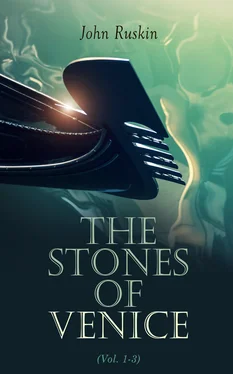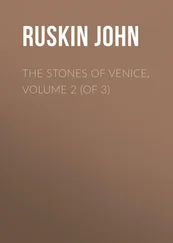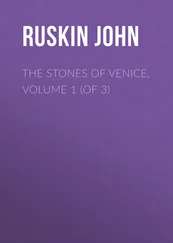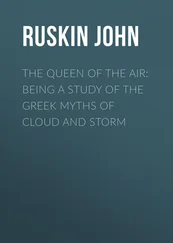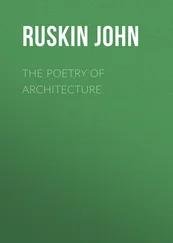§ XIX. I have not in this chapter spoken at all of the profiles which are given in Northern architecture to the projections of the lower members of the base, b and c in Fig. II., nor of the methods in which both these, and the rolls of the mouldings in Plate X., are decorated, especially in Roman architecture, with superadded chain work or chasing of various patterns. Of the first I have not spoken, because I shall have no occasion to allude to them in the following essay; nor of the second, because I consider them barbarisms. Decorated rolls and decorated ogee profiles, such, for instance, as the base of the Arc de l’Etoile at Paris, are among the richest and farthest refinements of decorative appliances; and they ought always to be reserved for jambs, cornices, and archivolts: if you begin with them in the base, you have no power of refining your decorations as you ascend, and, which is still worse, you put your most delicate work on the jutting portions of the foundation—the very portions which are most exposed to abrasion. The best expression of a base is that of stern endurance—the look of being able to bear roughing; or, if the whole building is so delicate that no one can be expected to treat even its base with unkindness, 80then at least the expression of quiet, prefatory simplicity. The angle spur may receive such decoration as we have seen, because it is one of the most important features in the whole building; and the eye is always so attracted to it that it cannot be in rich architecture left altogether blank; the eye is stayed upon it by its position, but glides, and ought to glide, along the basic rolls to take measurement of their length: and even with all this added fitness, the ornament of the basic spur is best, in the long run, when it is boldest and simplest. The base above described, § XVIII., as the most beautiful I ever saw, was not for that reason the best I ever saw: beautiful in its place, in a quiet corner of a Baptistery sheeted with jasper and alabaster, it would have been utterly wrong, nay, even offensive, if used in sterner work, or repeated along a whole colonnade. The base No. 10 of Plate XII.is the richest with which I was ever perfectly satisfied for general service; and the basic spurs of the building which I have named as the best Gothic monument in the world ( p. 141), have no ornament upon them whatever. The adaptation, therefore, of rich cornice and roll mouldings to the level and ordinary lines of bases, whether of walls or shafts, I hold to be one of the worst barbarisms which the Roman and Renaissance architects ever committed; and that nothing can afterwards redeem the effeminacy and vulgarity of the buildings in which it prominently takes place.
§ XX. I have also passed over, without present notice, the fantastic bases formed by couchant animals, which sustain many Lombardic shafts. The pillars they support have independent bases of the ordinary kind; and the animal form beneath is less to be considered as a true base (though often exquisitely combined with it, as in the shaft on the south-west angle of the cathedral of Genoa) than as a piece of sculpture, otherwise necessary to the nobility of the building, and deriving its value from its special positive fulfilment of expressional purposes, with which we have here no concern. As the embodiment of a wild superstition, and the representation of supernatural powers, their appeal to the imagination sets at utter defiance all judgment based on ordinary canons of law; and the magnificence of their treatment atones, in nearly every case, for the extravagance of their conception. I should not admit this appeal to the imagination, if it had been made by a nation in whom the powers of body and mind had been languid; but by the Lombard, strong in all the realities of human life, we need not fear being led astray: the visions of a distempered fancy are not indeed permitted to replace the truth, or set aside the laws of science: but the imagination which is thoroughly under the command of the intelligent will, 81has a dominion indiscernible by science, and illimitable by law; and we may acknowledge the authority of the Lombardic gryphons in the mere splendor of their presence, without thinking idolatry an excuse for mechanical misconstruction, or dreading to be called upon, in other cases, to admire a systemless architecture, because it may happen to have sprung from an irrational religion.
78Another most important reason for the peculiar sufficiency and value of this base, especially as opposed to the bulging forms of the single or double roll, without the cavetto, has been suggested by the writer of the Essay on the Æsthetics of Gothic Architecture in the British Quarterly for August, 1849:—“The Attic base recedes at the point where, if it suffered from superincumbent weight, it would bulge out.”
79I have put in Appendix 24, “Renaissance Bases,” my memorandum written respecting this building on the spot. But the reader had better delay referring to it, until we have completed our examination of ornaments in shafts and capitals.
80Appendix 25, “Romanist Decoration of Bases.”
81In all the wildness of the Lombardic fancy (described in Appendix 8), this command of the will over its action is as distinct as it is stern. The fancy is, in the early work of the nation, visibly diseased; but never the will, nor the reason.
Конец ознакомительного фрагмента.
Текст предоставлен ООО «ЛитРес».
Прочитайте эту книгу целиком, купив полную легальную версию на ЛитРес.
Безопасно оплатить книгу можно банковской картой Visa, MasterCard, Maestro, со счета мобильного телефона, с платежного терминала, в салоне МТС или Связной, через PayPal, WebMoney, Яндекс.Деньги, QIWI Кошелек, бонусными картами или другим удобным Вам способом.
